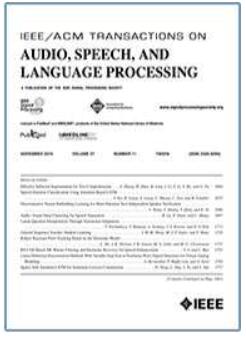用于自动钢琴转写的谐波感知频率和时间注意事项
IF 5.1
2区 计算机科学
Q1 ACOUSTICS
IEEE/ACM Transactions on Audio, Speech, and Language Processing
Pub Date : 2024-06-28
DOI:10.1109/TASLP.2024.3419441
引用次数: 0
摘要
自动音乐转录(AMT)是将音乐音频转录为音符符号表示。在目前的研究中,频域和时域重叠的并发音符仍然阻碍着复调钢琴转写的性能。在这项工作中,我们开发了一种基于注意力的钢琴转写方法,其中我们提出了一种谐波感知注意力来捕捉音乐的频率结构,以及一种局部时间注意力来模拟时间依赖性。谐波感知频率注意不仅强调了明显谐波之间的关系,还提取了残余非谐波成分中的相关性。利用可学习的注意力范围掩码改进了时间注意力机制,以模拟不同子任务的帧短期依赖关系。在 MAESTRO 数据集上的实验表明,所提出的系统在帧和音符的 F1 指标上都达到了最先进的转录性能。考虑到钢琴踏板的动态行为对音符持续时间的影响,还提出了一种音符持续时间修改方法。通过对 MAESTRO 上的偏移量进行更精确的注释,转录性能得到了进一步提高。本文章由计算机程序翻译,如有差异,请以英文原文为准。
Harmonic-Aware Frequency and Time Attention for Automatic Piano Transcription
Automatic music transcription (AMT) is to transcribe music audio into note symbol representations. Concurrent notes overlapping in the frequency and time domains still hinder the performance of polyphonic piano transcription in current studies. In this work, we develop an attention-based method for piano transcription, where we propose a harmonic-aware attention to capture the musical frequency structure, and a local time attention to model temporal dependencies. The harmonic-aware frequency attention not only emphasizes the relationship between the obvious harmonics, but also extracts the correlation in the residual non-harmonic component. The time attention mechanism is improved using the learnable attention range masks to model frame-wise short-term dependencies on different subtasks. Experiments on the MAESTRO dataset demonstrate that the proposed system achieves state-of-the-art transcription performance on both frame-wise and note-wise F1 metrics. Considering the influence of the piano pedals' dynamic behavior on note duration, a note duration modification method is also proposed. With a more accurate annotation of the offset on MAESTRO, the transcription performance is further improved.
求助全文
通过发布文献求助,成功后即可免费获取论文全文。
去求助
来源期刊

IEEE/ACM Transactions on Audio, Speech, and Language Processing
ACOUSTICS-ENGINEERING, ELECTRICAL & ELECTRONIC
CiteScore
11.30
自引率
11.10%
发文量
217
期刊介绍:
The IEEE/ACM Transactions on Audio, Speech, and Language Processing covers audio, speech and language processing and the sciences that support them. In audio processing: transducers, room acoustics, active sound control, human audition, analysis/synthesis/coding of music, and consumer audio. In speech processing: areas such as speech analysis, synthesis, coding, speech and speaker recognition, speech production and perception, and speech enhancement. In language processing: speech and text analysis, understanding, generation, dialog management, translation, summarization, question answering and document indexing and retrieval, as well as general language modeling.
 求助内容:
求助内容: 应助结果提醒方式:
应助结果提醒方式:


